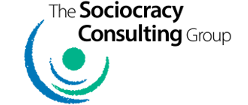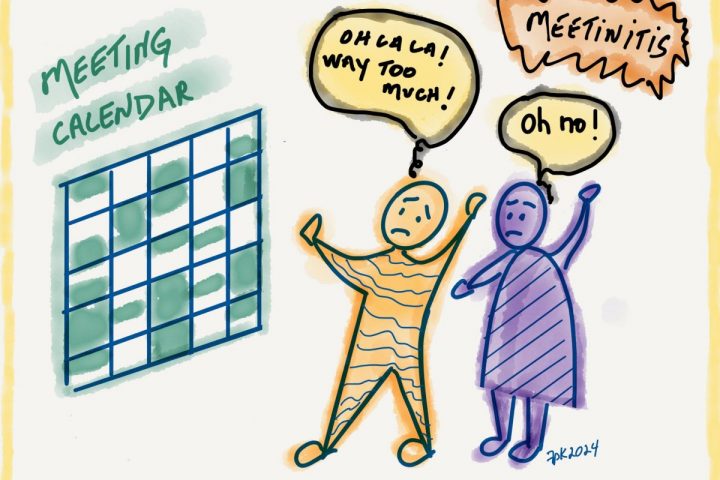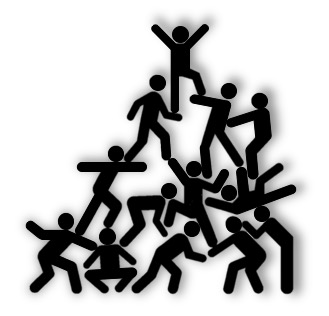 This is the third in a three-part series, and is an excerpt from a white paper by the same title.
This is the third in a three-part series, and is an excerpt from a white paper by the same title.
Part 1 and part 2 listed four pitfalls of a top-down organization: (1) communication goes one-way, (2) the person who makes the decisions creates a bottleneck, (3) management and workers become adversaries, and (4) workers disengage. Here is the last of the five pitfalls, and then a discussion of how to put it all together to steer an organization.
Pitfall #5. The organization loses sources of information and creativity.
In a natural system, every part of the whole has information needed by the rest of the system. In the human body for example, every cell senses information that can affect what happens in other parts of the body. The endocrine system, the nervous system, the gut, and the other organ systems all talk to each other. If the body were to ignore the information from any part, the result could be damage, disease or death. This also applies at the organ level for the body, and at the cellular level within an organ.
Likewise, our human organizations have rich sources of information among their own members, if only they can access it. We need the perspectives both of the people at the head of the organization, who have the job to think about the whole company and the long-term strategic objectives, and of the people on the front line, who know what they need to do their work and are likely closer to the customer. Perhaps in the past, when external conditions have been more stable and predictable, we could get away with static, top-down organizations. The pace of change is so rapid now that our organizations need new ways of adapting and responding . The old predict-and-control no longer suffices. And all the challenges facing humanity require the intelligence and creativity of people in all parts of our organizations to create positive impact. The Sociocratic Circle Method (SCM) provides a way to access this creative intelligence. See Case Study and User Comment #1 below.
Case Study
Rainbow Community School, for pre-schoolers through 8th graders in Asheville, NC, had a culture of encouraging input from all stakeholders – teachers, staff, students, and parents. Yet structurally and legally, decisions rested on the shoulders of the Executive Director. When they began implementing the SCM, it was as though a breath of fresh air blew through the place. Teachers started taking initiative with all sorts of creative ideas. The circle structure with clear aims and domains made it clear who had responsibility and authority for what, and people no longer needed permission to take action. The result was to unleash an entrepreneurial spirit, to the benefit of the students and their parents. A decade later, the school’s enrollment and size of the campus had more than doubled, with a reputation as an innovative community leader.
User Comment #1
“Since we’ve adopted sociocracy, it’s much easier and more efficient for me to delegate. I’m able to receive information from the staff, the faculty, and all the different committees in a much more efficient fashion. I can’t tell you how much more enjoyable my job is.”
– Renee Owen, Executive Director, Rainbow Community School, Asheville, NC, using sociocracy since 2009
Putting It All Together to Steer an Organization
If every decision required a meeting to consent to a policy, work would progress slowly. So the SCM distinguishes between policy and operational decisions. Policy, to which a circle consents, guides day-to-day operational decisions. For day-to-day work, the linear structure is in place, for efficiency and accountability. For making policy decisions, the circle structure is in place. We go back and forth between the structures in Figures 1a and 1b (below), and get the best of both worlds. And meetings for policy and meetings for operational decisions are separate.
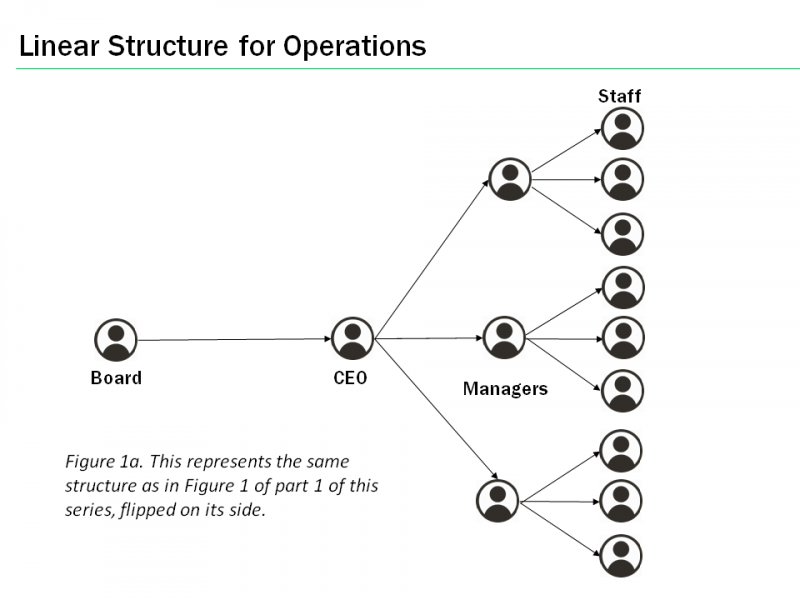
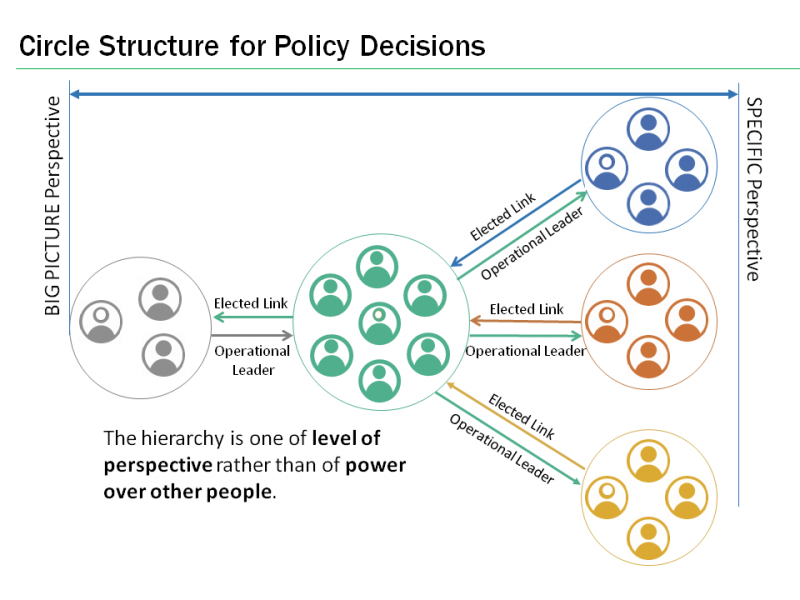
We need two more pieces to steer an organization: feedback loops for continuous improvement, and clear processes for meetings and decision-making.
Feedback Loops
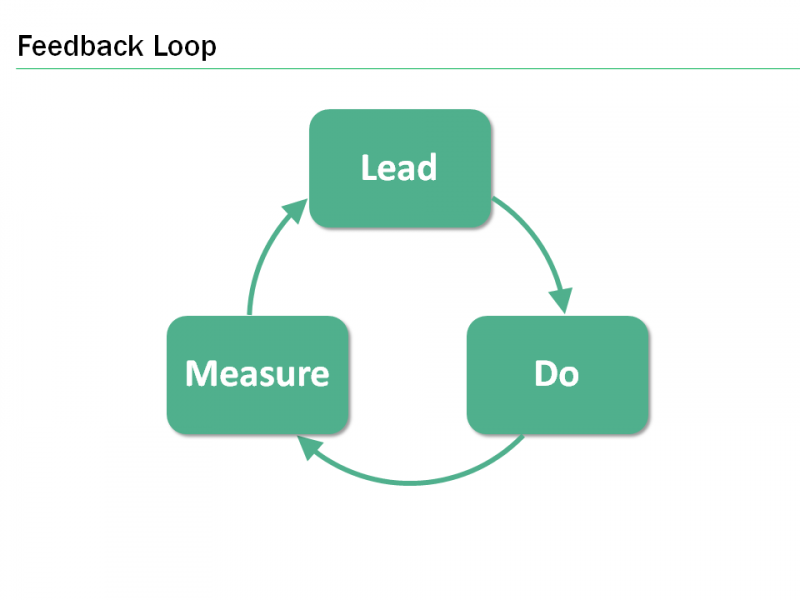
Every policy becomes an experiment for a set a time period and includes measures. The goal of the policy is clear at the outset, as is how long to conduct the experiment and how to measure its success. At the end of that time period, the circle that created the policy reviews the measurements and evaluates how well the policy helps achieve the desired goal. They can then do one of three things: renew the policy, change it, or toss it out and start over. See Figure 2. Double-linking between circles creates another critical feedback loop, and means that information about the effectiveness of a circle’s policy can come from anywhere in the organization.
Meetings
Meetings, while necessary, can be the blessing or the curse of any organization – and sometimes they are both. The SCM includes careful design of policy meetings to hear all voices in the circle, to make group decisions, and to continuously improve the meeting effectiveness. All circle members receive training to hold a circle meeting, and the meeting facilitator receives extra training. See User Comment #2 below. Meetings where all voices are heard and the group gets things done are a key part of being able to steer an effective, responsive organization.
User Comment #2
“Sociocracy has allowed us to have open-hearted conversations about emotionally-laden topics and develop policies we were not able to handle before. One visitor, new to sociocracy, was in awe of the trust and open communication in our meeting.”
– Cynthia Kennedy, Founding Member, Open Floor International, using sociocracy since 2013
The Paradox of Self-Organizing Systems
Many leaders tend to think endurance and resilience of their organization come from imposing control on structures and processes. But with change so rapid, the old mindset of “predict and control” is an illusion. The paradox is that by transitioning from what may feel like control to self-organization, companies can become more flexible and resilient, and therefore more likely to endure in the long run.
The SCM is a whole-systems approach to decision-making, governance, and project management. It creates more inclusive, resilient, and effective organizations where all stakeholders have a voice on the policies affecting their work. See User Comments #3 and #4 (below). For the technically minded, the approach draws on cybernetics and systems theory (Buck & Endenburg, 2012; Buck & Villines, 2017). Self-organizing systems are adaptive and resilient rather than rigid and stable (Wheatley, 2006); a sociocratic organization is self-organizing. The SCM has been found to increase productivity and, where it has been measured, to increase it by 30-40%; it increases worker retention rates and reduces sick leave (Buck & Villines, 2017). It also enables companies to respond more appropriately to customer needs.
User Comment #3
“Sociocracy has made a big difference in Creative Urethanes’ ability to withstand the economic downturn. We saw increased profits within the first year of using the method. Over time we have applied it to many areas of the company. As a result, we have better communication throughout the company, lower employee turnover, more energy in staff members due to increased involvement, more creative ideas that help us thrive in our industry, and continuous improvement within the organization. Best for me is I have more assistance – having everyone’s help during hard economic times has lifted some weight off my shoulders.”
– Richard Heitfield, President, Creative Urethanes, Winchester, Virginia, using sociocracy since the 1980’s
User Comment #4
“Sociocracy shifts us away from the old command-and-control structures with which most of us grew up – structures that often fostered fear, control, and competition among people. What we have instead now is a system that fosters cooperation and trust, allowing room for a new way of working together. It’s beautiful to witness.”
– Cynthia Kennedy, Founding Member, Open Floor International, using sociocracy since 2013
And what of Jane, Fred, and Francesca, our characters at the beginning of part 1 of this series? How do they benefit? Francesca has a voice in the decisions affecting her work, knowing that her ideas and skills matter. Fred is no longer caught in the middle between representing the boss to the workers and advocating on behalf of the workers to the boss. And Jane has access to information, ideas, and solutions beyond what she as one leader can devise on her own.
Sources
- John A. Buck and Gerard Endenburg, 2012, “The Creative Forces of Self-Organization.”
- John Buck and Sharon Villines, 2017, We the People: Consenting to a Deeper Democracy, 2nd edition. Washington, DC: Sociocracy.info.
- Margaret J. Wheatley, 2006, Leadership and the New Science: Discovering Order in a Chaotic World, 3rd edition. Oakland, CA: Berrett-Koehler Publishers.
 Sheella Mierson, Ph.D., a founding member of The Sociocracy Consulting Group, consults with organizations to clarify business objectives and create adaptive structures and processes to achieve them. Contact us for a free consultation.
Sheella Mierson, Ph.D., a founding member of The Sociocracy Consulting Group, consults with organizations to clarify business objectives and create adaptive structures and processes to achieve them. Contact us for a free consultation.
